
Sciaroidea is a superfamily in the infraorder Bibionomorpha. There are about 16 families and more than 15,000 described species in Sciaroidea. Most of its constituent families are various gnats.
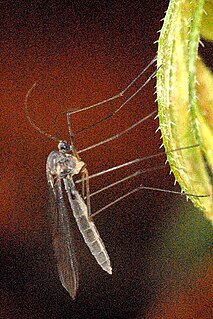
Bolitophila is the sole genus in the Bolitophilidae, a family of Diptera, with around 40 Palaearctic and about 20 Nearctic species, and three species from the Oriental region (Taiwan). They are small (6–9 mm.)

Bolitophila cinerea is a Palearctic species of 'fungus gnat' in the family Bolitophilidae.
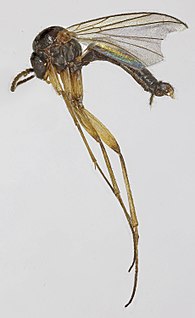
Acnemia nitidicollis is a Palearctic species of 'fungus gnat' in the family Mycetophilidae.The larvae of Acnemia are mycetophagous in rotting wood.
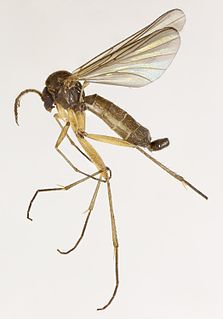
Boletina griphoides is a Palearctic species of 'fungus gnat' in the family Mycetophilidae.The larvae of B. griphoides are thought to be mycetophagous in the ground litter. Adults sometimes appear in enormous numbers in spring in a wide variety of habitats.
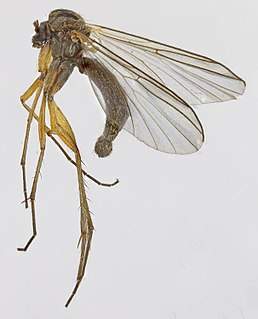
Boletina trispinosa is a Palearctic species of 'fungus gnat' in the family Mycetophilidae. Members of this genus are found in a wider variety of habitats from wooded streams to wetlands and open moorland. They make use of diverse breeding sites from the more normal habitat of rotting wood to mosses and liverworts. The breeding biology of most species is largely unknown.

Cordyla flaviceps is a Palearctic species of 'fungus gnat' in the family Mycetophilidae.The type-locality is Copenhagen (Denmark). C. flavicepsis a mycetophage associated with Russula and Lactarius.

Diadocidia ferruginosa is a Palearctic species of fungus gnat in the family Mycetophilidae. They live as larvae in long dry silken tubes under bark or in rotten wood and probably feed on fungal mycelia or spores. Also associated with Peniophora.
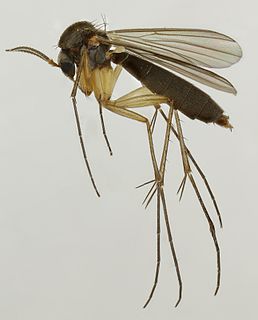
Exechia spinuligera is a Palearctic species of fungus gnat in the family Mycetophilidae. Exechia contaminata is chiefly or exclusively associated with Russula and Lactarius.

Mycetophila formosa is a Palearctic species of 'fungus gnat' in the family Mycetophilidae. Mycetophila formosa is found in forest or wooded areas where the larvae develop in Phlebia radiata and moist, strongly decayed wood of birch and spruce log bearing Trechispora hymenocystis.
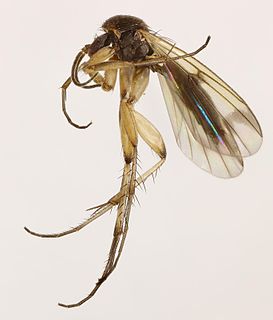
Mycetophila luctuosa is a Palearctic species of 'fungus gnats' in the family Mycetophilidae. Mycetophila luctuosa is found in forest or wooded areas where the larvae develop in Neolentinus lepideus, Kretzschmaria deusta, Chondrostereum purpureum, Sebacina incrustans, Neolentinus tigrinus, Pleurotus spp., Trametes versicolor and a wide range of epigeic fungi, mostly Russulaceae.
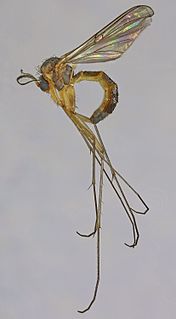
Mycomya cinerascens is a Palearctic species of 'fungus gnats' in the family Mycetophilidae. Mycomya cinerascens is found in forest or wooded areas where the larvae develop in fruiting bodies of Stereum, Thelephora terrestris and Cortinarius sp..Besides fruiting bodies the species has been collected with emergence traps over beech logs and stumps, alder and spruce stumps.

Brachypeza bisignata is a Palearctic species of 'fungus gnat' in the family Mycetophilidae. Reared from puffballs (Lycoperdales).

Boletina trivittata is a Palearctic species of 'fungus gnat' in the family Mycetophilidae. Members of this genus are found in a wider variety of habitats from wooded streams to wetlands and open moorland. Adults have been obtained in emergence traps in a range of situations including rotting wood and soil litter.
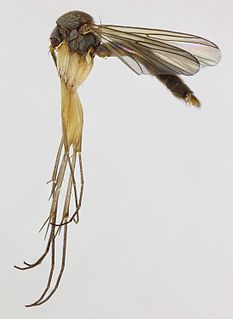
Brevicornu foliatum is a Palearctic species of 'fungus gnat' in the family Mycetophilidae. Members of this genus are found in a wider variety of habitats from wooded streams to wetlands and open moorland. Larvae develop in dead wood and in soil litter, feeding probably on microfungi.
Sciophilinae is a subfamily of fungus gnats. There are at least 40 genera and 340 described species in Sciophilinae.

Boletina is a genus of fungus gnats in the family Mycetophilidae. There are at least 30 described species in Boletina.
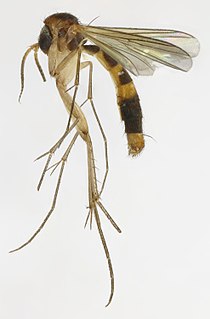
Mycetophilinae is a subfamily of fungus gnats in the family Mycetophilidae. There are more than 30 genera and 2,000 described species in Mycetophilinae.
Ectrepesthoneura is a genus of fungus gnats in the family Mycetophilidae. There are more than 20 described species in Ectrepesthoneura.
Nervijuncta is a genus of fungus gnats in the family Ditomyiidae.

















